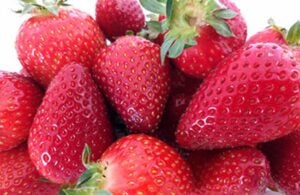Strawberries are usually the main attraction when it comes to springtime produce. Who can resist a strawberry from the fields on a late spring day? Especially when it is bursting with flavor and can be incorporated into smoothies, desserts, syrups, preserves, or just a raw, healthy snack.
The truth is that not many can turn down a fresh strawberry. That’s why the Agricultural Research Service’s strawberry breeding program in Beltsville, Maryland. is shaking up your Valentine’s Day with news of a new cultivar called Lumina that produces lustrous bright red strawberries that are large and sweet.
Early research results quickly showed that ‘Lumina’ consistently provided high yields of large, sweet, boldly colored, and glossy strawberries that were marketable in the earliest part of the Mid-Atlantic strawberry season. They’re also relatively resistant to foliar diseases present in the field leading to low rot at harvest, as well as during postharvest storage.

Anthracnose fruit rot routinely destroys a high percentage of strawberries grown during the traditional season and can even occur during cold storage. The plant disease favors hot, humid, rainy weather, but ‘Lumina’ is unique in that there has been little to no evidence of anthracnose affecting the cultivar.
“No fumigation or fungicides were used on ‘Lumina’ in the field,” said USDA-ARS Research Plant Geneticist Kim Lewers. “This is remarkable. Our research shows that after two weeks in post-harvest storage, ‘Lumina’ fruits were 24 percent more marketable than its early-season predecessor.”
‘Lumina’ is expected to be adapted to the Mid-Atlantic region of the US and regions with a similar climate. The strawberry’s excellent shelf life is just an added benefit to the taste, that has been described as sweet with a notable creamy texture.
While most Mid-Atlantic strawberries yield fruit in mid to late May, ‘Lumina’ debuts earlier in the season and provides its delicious berry in late April to early May. The cultivar was approved for release in 2023 and will soon be patented. Distribution during the life of the patent is limited to requestors licensed to propagate.


